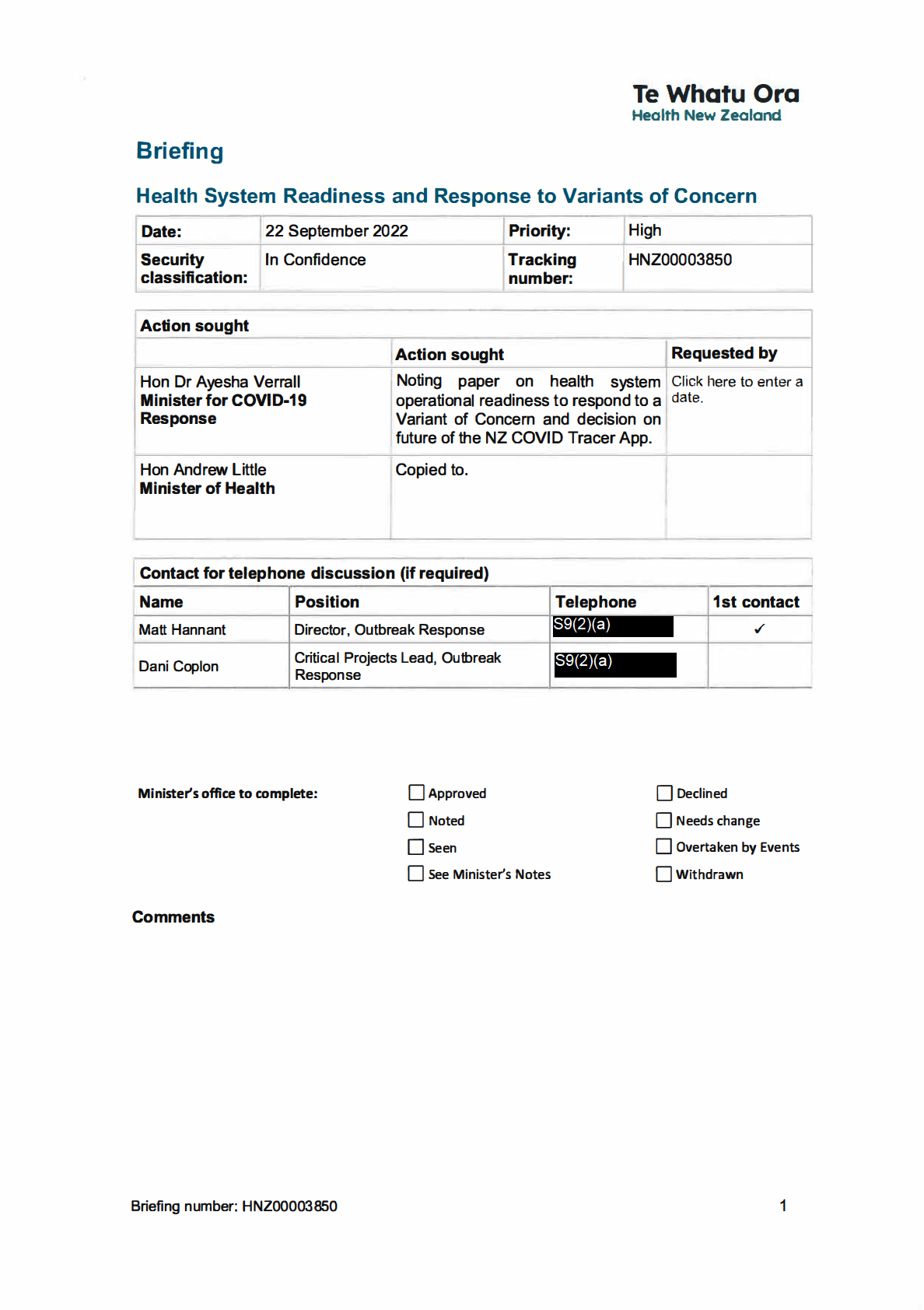
1982
ACT
INFORMATION
OFFICIAL
THE
UNDER
RELEASED
 TeWhatu Ora
TeWhatu Ora
Health
New Zealand
Briefing
Health System Readiness and Response to Variants of Concern
Date:
22 September 2022
Priority:
I High
I
Security
In Confidence
Tracking
I
I HNZ00003850
classification:
number:
!1982
Purpose
1. This briefing provides you with a detailed report back on health system preparednessACT
and readiness to respond to future COVID-19 Variants of Concern (VoC) [CAB -22-MIN
- 0223), and also seeks your decision on the future of the NZ COVID Tracer App.
Summary
2. New Zealand's response to COVID-19 has been world leading and has kept many
people safe from the worst effects of the pandemic.
3. Throughout the COVID-19 pandemic, we have developed and maintained a robust set of
public health measures to respond to any VoC if required. There have been many
lessons learned and a wealth of knowledge has been gained.
INFORMATION
4. We now have the required baseline and reserve measures in place that will best get us
through the next phase of the COVID-19 pandemic, emerging VoC, and further global
pandemics.
5. We know how to better target resources to achieve more equitable outcomes for our
priority populations. A renewed focus in the event of a new variant, would hasten the
deployment of tailored services and information to support Maori, Pacific, disabled
people and ethnic communities. OFFICIAL
6. To inform preparedness across government, Manat0 Hauora alongside Outbreak
Response, within the National Public Health Service (NPHS) in Te Whatu Ora have
THE
developed five variant scenarios. Each scenario reflects a VoC with differing severity and
degree of transmissibility. The five scenarios are outlined in the Variants of Concern
Strategic Framework (the Framework).
7. The Framework is built on scientific research, global responses to date, and operational
considerations. It outlines the different public health measures and how they would differ
based on each of the variant
UNDER scenarios, for example, what would happen regarding
testing, contact tracing, isolation, and testing.
8. Under this framework, we will continue to rely on a multi-layered system of defence to
ensure our systems, service providers and communities are resilient, our most
vulnerable are protected, and that any disruptions to health, business, social and
education outcomes are minimised.
9. Underpinning the response measures available to us are the foundations supporting
these measures,
RELEASED what we call our 'core enablers' of preparedness, readiness and
response. These enablers sit across the health system, are interdependent, and together
make up essential components of an effective COVID-19 response.
10. Our enablers are based on the World Health Organisations (WHO) recent release of the
2022 COVID-19 Strategic Preparedness and Response Plan and include:
Briefing number: HNZ00003850
2

1982
ACT
INFORMATION
OFFICIAL
THE
UNDER
RELEASED



 TeWhatu Ora
Health New Zealand
TeWhatu Ora
Health New Zealand
onwards, to reduce the scope to Bluetooth only, with a review of this
in May 2023;
or
(5)1No
Agree for Te Whatu Ora Officials to provide further advice regarding
the digital enablers to support contact tracing for VOCs and other
communicable diseases;
1982
h)
Note that the ongoing health system response to Omicron has
represented a cost beyond what we could have prepared for;
i)
Note that further advice will be provided to you regarding the
ACT
financial position of the health system response to COVID-19, for
your discussion with the Minister of Finance;
j)
Note that a report back will be provided to you on the transition of
Care in the Community functions into business as usual operations
in early October.
INFORMATION
Nick Chamberlain
National Director, National Public Health
Service
OFFICIAL
THE
Hon Dr Ayesha Verrall
Minister for COVID-19 Response
2.q, . UNDER
(01?2
RELEASED
Briefing number: HNZ00003850
4
 TeWhatu Ora
TeWhatu Ora
Health New Zealand
Background
13. On 13 June 2022, you presented a paper to Cabinet (the Cabinet paper) outlining New
Zealand's approach to responding to COVID-19 VoC and provided an initial overview of
preparedness across the health system and non-health COVID-19 response agencies
[CAB-22-M I N-0223].
1982
14. The Cabinet paper outlined that while the COVID-19 pandemic is now on a relatively
known trajectory, its path is ultimately unpredictable. In order to ensure we are able to
respond adequately to a VoC if required, we must undertake robust preparedness across
government.
ACT
15. Cabinet directed Manat0 Hauora with support from Te Whatu Ora and Te Aka Whai Ora
to report back on health system preparedness, including but not limited to detail of
anticipated testing modality and capacity requirements, contact tracing approach, and
resource requirements across scenarios and outbreak stages. The operational
responsibilities for the COVID-19 transitioned to Te Whatu Ora on 1 July 2022.
16. This briefing details the ongoing work to strengthen core components of preparedness
across our health system and enable us to be well prepared for any VoC while
supporting resilience across our health system.
Strategic approach to new variants of concern
INFORMATION
Variants of Concern Strategic Framework
17. To assist preparedness and response planning for a VoC, Manato Hauora developed the
Variants of Concern Strategic Framework.
18. The Framework considers five different, plausible but hypothetical VoC scenarios, from
OFFICIAL
worst to best case scenario. These scenarios are:
• scenario 1: High clinical severity, high immune escape (worst case)
THE
• scenario 2: Low clinical severity, high immune escape
• scenario 3: High clinical severity, low immune escape
• scenario 4: Low clinical severity, low immune escape (best case)
UNDER
• scenario 5: Multiple co-circulating variants with different levels of severity and
different levels of cross-protection.
19. It is important to note that the characteristics of any new VoC are ultimately unknown,
including its transmissibility and clinical impacts. However, what is known is that any new
VoC will likely be more infectious than previous variants to be able to gain a foothold.
20. At the overarching level, the objectives to any response remain the same: reduce and
control the incidence of COVID-19 infections and prevent, diagnose and treat COVID-19
RELEASED
to reduce mortality, mobility and long-term clinical impacts.
21. To support these overarching objectives the Variants of Concern Strategic Framework
sets out a response framework, which is applied across scenarios and made up of
Briefing number: HNZ00003850
5
 TeWhatu Ora
Health New Zealand
TeWhatu Ora
Health New Zealand
specific objectives. This is dependent on the maturity of any VoC approaching the border
or within the community.
22. These response objectives are:
•
prepare: system is alerted to a new Voe - system readies to pivot and if needed
to move to contain
•
contain: first community case - system pivots to reduce transmission
1982
•
manage: widespread community transmission - system pivots to preserving
critical infrastructure and protecting communities at greater risk and priority
populations.
ACT
Aligning the strategic direction with new approach to COVID-19
23. Since the development of the Variants of Concern Strategic Framework, New Zealand
has shifted its approach in responding to COVID-19. On 12 September 2022, the
Government announced the end of the COVID-19 Protection Framework.
24. The new, ongoing approach to COVID-19, builds on the Variants of Concern Strategic
Framework [CAB-22-MIN-0223; CAB-22-MIN-0380 refers]. The goal of the
Government's COVID-19 response is still protecting lives and livelihoods, reflected in
four principles: prepared, protective and resilient, and stable.
25. This is an enduring approach that can flex with the context and challenges that COVID-
INFORMATION
19 will present. It means managing COVID-19 more like other infectious diseases, based
on its impact on the health system and society. This approach relies on good voluntary
compliance with core public health advice as foundation (baseline measures) and retains
the ability to dial-up and layer on restrictions and requirements, if/when needed (reserve
measures). The use of these measures and the overall approach for responding to Voe
is outlined in the Variants of Concern Strategic Framework.
26. To maintain and enhance our preparedness for new VoC, a wide range of initiatives
OFFICIAL
have been undertaken. These initiatives are intended to either bolster baseline measures
to minimise the need for reserve measures to be used and to maintain stability or ensure
that reserve measures can be re-instated quickly and effectively.
THE
Health system preparedness
We have a
robust set of public health response measures available to us
27. With over two years of a dedicated response to COVID-19, we have developed and
maintained a robust set of
UNDER public health measures to respond to any VoC if required.
28. What measures we implement in response to a VoC depend on a range of factors
including the impact of the VoC on health outcomes, broader socio-economic impacts,
as well as considerations on expected pressures on the health system.
29. While we have the tools available to us to respond to an emerging threat, many of these
response measures are only required when the threat is great enough to warrant them.
As the threat of Omicron decreases over time, we no longer require as many of these
public health measures in place as part of our ongoing response.
RELEASED
30. As indicated in CAB-22-MIN-0223, many public health measures available to us exist
within a set of 'reserve measures' - available to us to respond with only when it is
proportionate to do so. As Omicron cases continue to track down, we are increasingly
able to transition remaining public health measures into our set of reserves.
Briefing number: HNZ00003850
6
 TeWhatu Ora
TeWhatu Ora
Health New Zealand
31. While we continue to transition our system and infrastructure to be more resilient to
shocks through preparedness planning, we also need to consider how and when we
would reactivate reserve measures or enhance baseline measures proportionate to
health risk if they were required.
Role of Public Health Risk Assessments
32. To ensure our response remains effective and proportionate, regular public health risk
assessments (PHRA) are undertaken to determine the most appropriate set of public
health measures required to manage the pandemic at the time of assessment.
1982
33. The most recent PHRA, undertaken on 17 August 2022, noted that New Zealand's
current COVID-19 outbreak is waning, with reducing case numbers, hospitalisations, and
deaths. Modelling suggested that this trend should continue for some time. However, it is
ACT
still unclear when the outbreak will plateau.
34. Given this, the PHRA recommended a step-down from most mandatory measures to
more voluntary measures, to ensure that our response remains proportionate to the
current risk posed by COVID-19. In light of this, the PHRA advised that an appropriate
review time would be 4-6 weeks from the date of any decision on measures.
35. The next PHRA is planned for the week commencing 3 October 2022, which will provide
the basis for further advice to Ministers in mid-October on whether public health
measures relying on orders under the COVID-19 Public Health Response Act 2020
continue to be justified beyond this time.
INFORMATION
36. The process by which we support the PHRA with operational considerations will be
retained while the COVID-19 Public Health Response Act 2020 (the Act) is in place
and until such time as adjustments can be made to other legal frameworks to manage
communicable disease and pandemics more broadly are strengthened.
Legal framework
37. Work to consider the legal implications for future responses is being progressed by
Manat0 Hauora, in partnership with the Department of
OFFICIAL Prime Minister and Cabinet
(DPMC).
38. To support the ongoing management of COVID-19 in the medium term, the Act will be
extended beyond May 2023, when
THE it is currently due to expire. Work on substantive
legislative amendments for responding to future epidemics will take place over the
next two or more years to enable recommendations from any formal inquiry into the
COVI D-19 response to be incorporated into the design of the future legislative work.
Readiness planning and assessments
39. Throughout July and August,
UNDER Te Whatu Ora alongside Manato Hauora, including the
Public Health Agency (PHA), have undertaken readiness exercises.
40. Outbreak Response, NPHS have led a readiness assessment against all key metrics
as agreed and confirmed with Ministers as part of ongoing work to provide
assurances that all
pillars across the COVID-19 Response are being addressed, to
provide an assurance that preventative measures are in place to alleviate stress and
burden on healthcare settings.
41. A VoC readiness assessment has been completed to provide an assurance that the
RELEASED
system can respond if a VoC was to present via global surveillance or domestic
surveillance.
Briefing number: HNZ00003850
7
 TeWhatu Ora
TeWhatu Ora
Health New Zealand
42. The results suggest that there were some further operational refinements that could
be made to better target the use of testing, surveillance and enabling operational
mechanisms within Care in the Community.
43. These refinements have resulted in an update to testing guidance, further refinements
and reviews of contact tracing and isolation requirements, streamlined clinical
assessment criteria in Care in Community and reviewed infection, prevention and
control advice.
44. Te Whatu Ora has also worked alongside agency partners across the All of
1982
Government response led by DPMC to support broad readiness planning for a Variant
of Concern and sustained management of our current Omicron response.
45. It is recognised that in the worst-case scenario, quarantine or isolation facilities may be
ACT
necessary to respond to a new variant. While our Managed Isolation and Quarantine
(MIQ) network has been decommissioned, a readiness plan has been developed to
support activation of quarantine and isolation capability if needed.
46. The Readiness Plan, when activated, will enable the Government to rapidly stand-up
quarantine and isolation capability within 3-4 weeks
1 as part of border control measures
in response to a significant public health threat. It is predicated on sufficient surge
workforces being made available urgently by partner agencies (in particular health and
defence force staff) and a full border closure being in place (or in the process of being
implemented) when the Plan is activated, and that quarantine and isolation capability will
be in support of border arrivals.
INFORMATION
47. We have also actively repurposed some of our work with VoC, to put in place a
strategic prepare and readiness framework for use across novel virus and other
communicable disease. Our recent response to Monkeypox has shown how far we
have come since 2020 in our ability to manage a local response that is regionally led
and nationally enabled.
48. Given the work that has been undertaken, we believe that we remain prepared and
ready for a Voe.
OFFICIAL
Core enablers of preparedness
49. Underpinning the response measures available to us are the foundations supporting
THE
these measures, what we call our 'core enablers' of preparedness, readiness and
response. These enablers sit across the health system, are interdependent and together
make up essential components of an effective COVID-19 response.
50. Our enablers are based on the WHO's recent release of the 2022 COVID-19 Strategic
Preparedness and Response plan and include:
UNDER
• surveillance, outbreak investigation
• laboratories and diagnostics
• IPC and protection of the health and disability workforce
RELEASED
The plan assumes that self isolation will be the interim default position while quarantine and isolation capability is re
established and that other appropriate steps will be taken in parallel (for example pre departure tests) to ensure that risk is
kept offshore as much as possible. If a border closure were implemented with no self isolation option in the interim period
while MIQ was being re established, this would likely result in significant cases of distress among stranded offshore New
Zealanders; this would be compounded by a likely immediate reduction of commercial inbound air route capacity. This issue
would be of a type and scale that could not be managed or resolved via consular support from New Zealand officials
offshore.
Briefing number: HNZ00003850
8
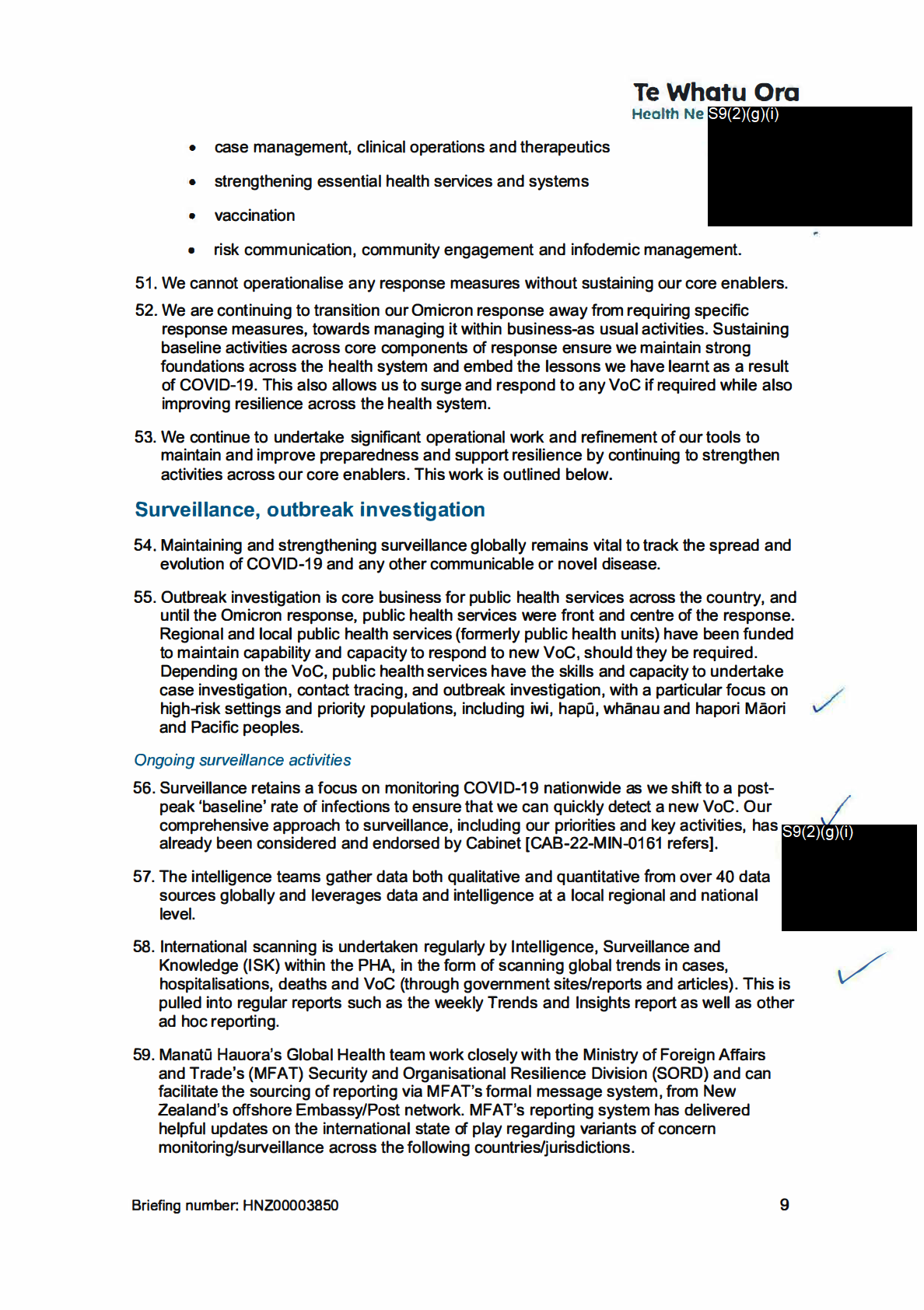
1982
ACT
INFORMATION
OFFICIAL
THE
UNDER
RELEASED
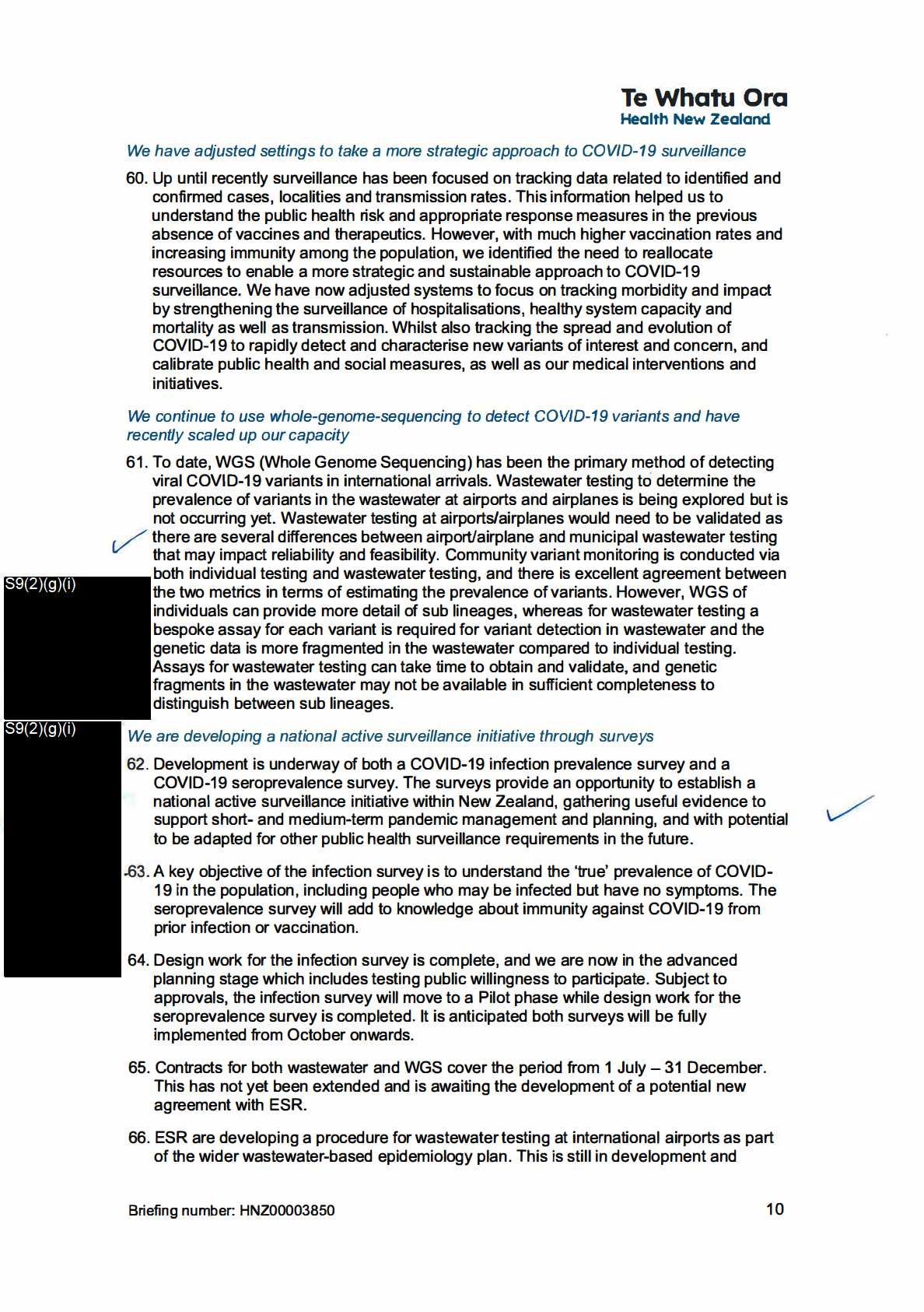
1982
ACT
INFORMATION
OFFICIAL
THE
UNDER
RELEASED
 TeWhatu Ora
Health New Zealand
TeWhatu Ora
Health New Zealand
requires more work with regard to relationships with international airports, service
providers for sampling and use of in-house genomics capability. Once fully developed,
this will provide a 'first look' at what variants have entered the country at the border.
Case investigation and contact tracing
67. The case investigation and contact tracing system has evolved significantly since March
2020. Due to investment in case investigation capabilities, the system now has a
sizeable and highly skilled workforce, and mature operating procedures, tools and
systems, and knowledge.
1982
68. Te Whatu Ora alongside Manato Hauora continue to review case and household
isolation periods and testing advice to ensure it remains proportionate, in line with
evidence and modelling. We prioritise our case investigation caller capacity to ensure we
ACT
deliver equitable outcomes. The prioritisation criteria is reviewed in light of changing
case numbers to ensure that we are utilising our capacity appropriately.
69. The contact tracing system enablers and workforce capability remain available to support
contact tracing activities as required.
70. Our baseline measures include:
• the delivery of the phone-based and electronic case investigations.
• the isolation of cases and household contacts
• the use of Bluetooth notifications
INFORMATION
• guidance for cases to inform their contacts of exposure.
71. Our reserve measures include:
• push notifications
• quarantine and testing advice for close contacts.
OFFICIAL
72. Given the downscaling of response measures including removal of quarantine
requirements for household contacts, significant public health rationale demonstrating
THE
proportionality would be required to reinstate these reserve measures, to justify the
burden to wider society.
73. The self-management model that was employed as a result of the widespread Omicron
outbreak has been effective and is likely to remain so in response to any emerging VoC.
The utilisation of contact tracing resources will continue to provide the greatest benefit
UNDER
when prioritised for those with the greatest risk of adverse health outcomes.
74. Te Whatu Ora's National Investigation and Tracing Centre, within NPHS continues to
review the use and benefit of digitally enabled tools for self-management of COVID-19.
NZ COVID Tracer App
75. In assessing the appropriate use of NZ COVID Tracer App in response to a VOC,
consideration has been given to the following:
• any
RELEASED new emerging variant is likely to have a transmission advantage over
previous variants, therefore efficient automated processes are required to aid the
response
Briefing number: HNZ00003850
11

1982
ACT
INFORMATION
OFFICIAL
THE
UNDER
RELEASED
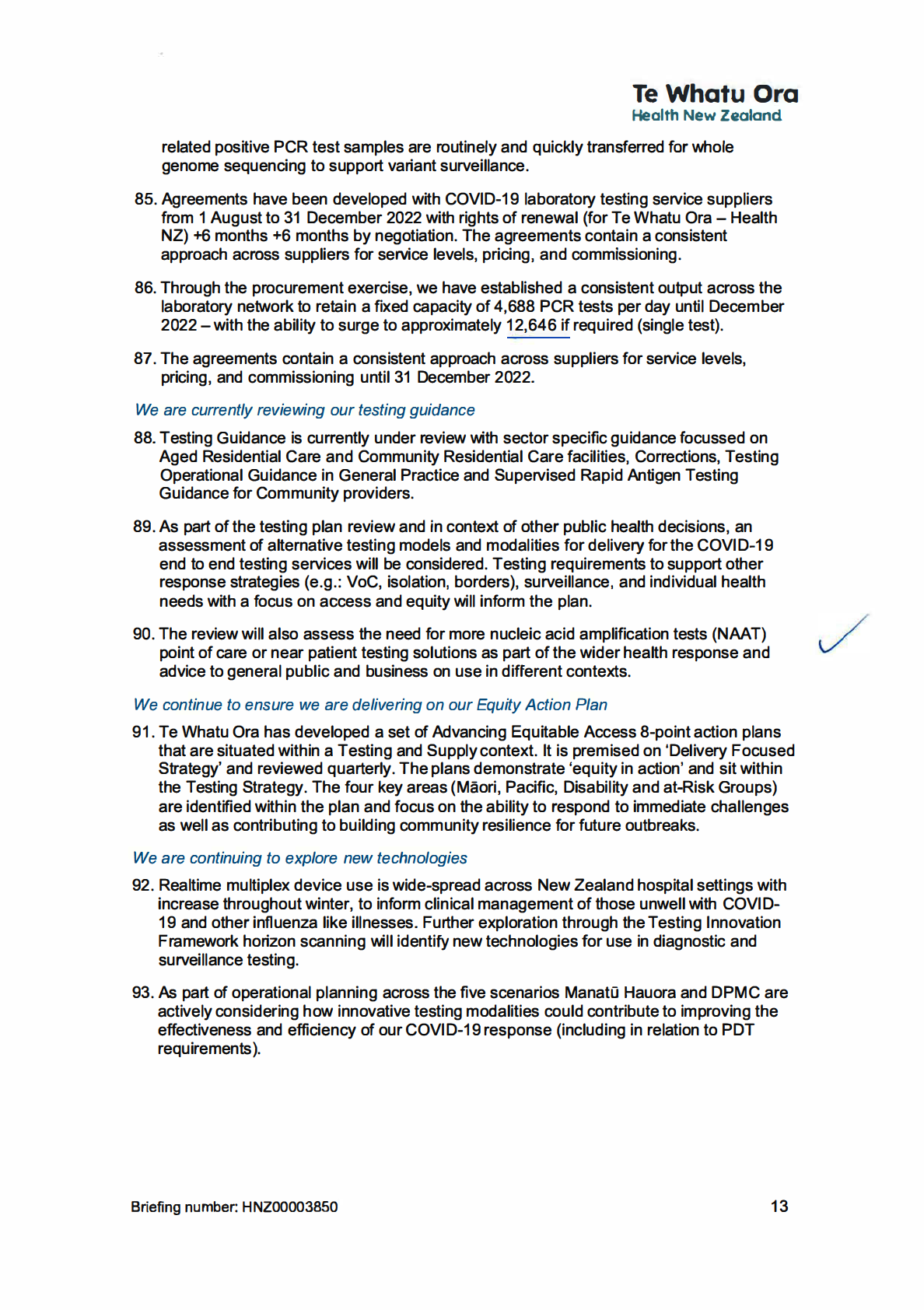
1982
ACT
INFORMATION
OFFICIAL
THE
UNDER
RELEASED
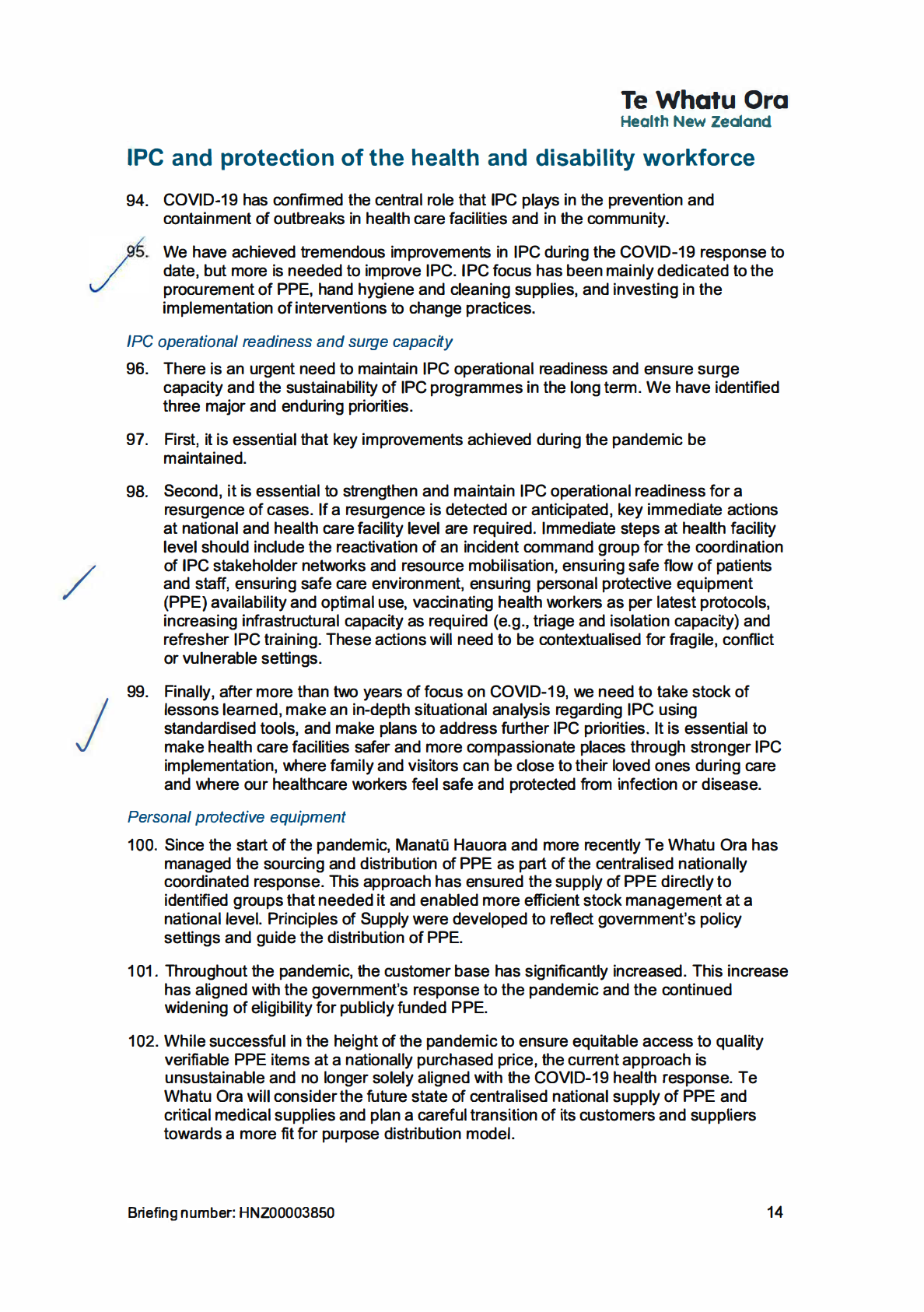
1982
ACT
INFORMATION
OFFICIAL
THE
UNDER
RELEASED
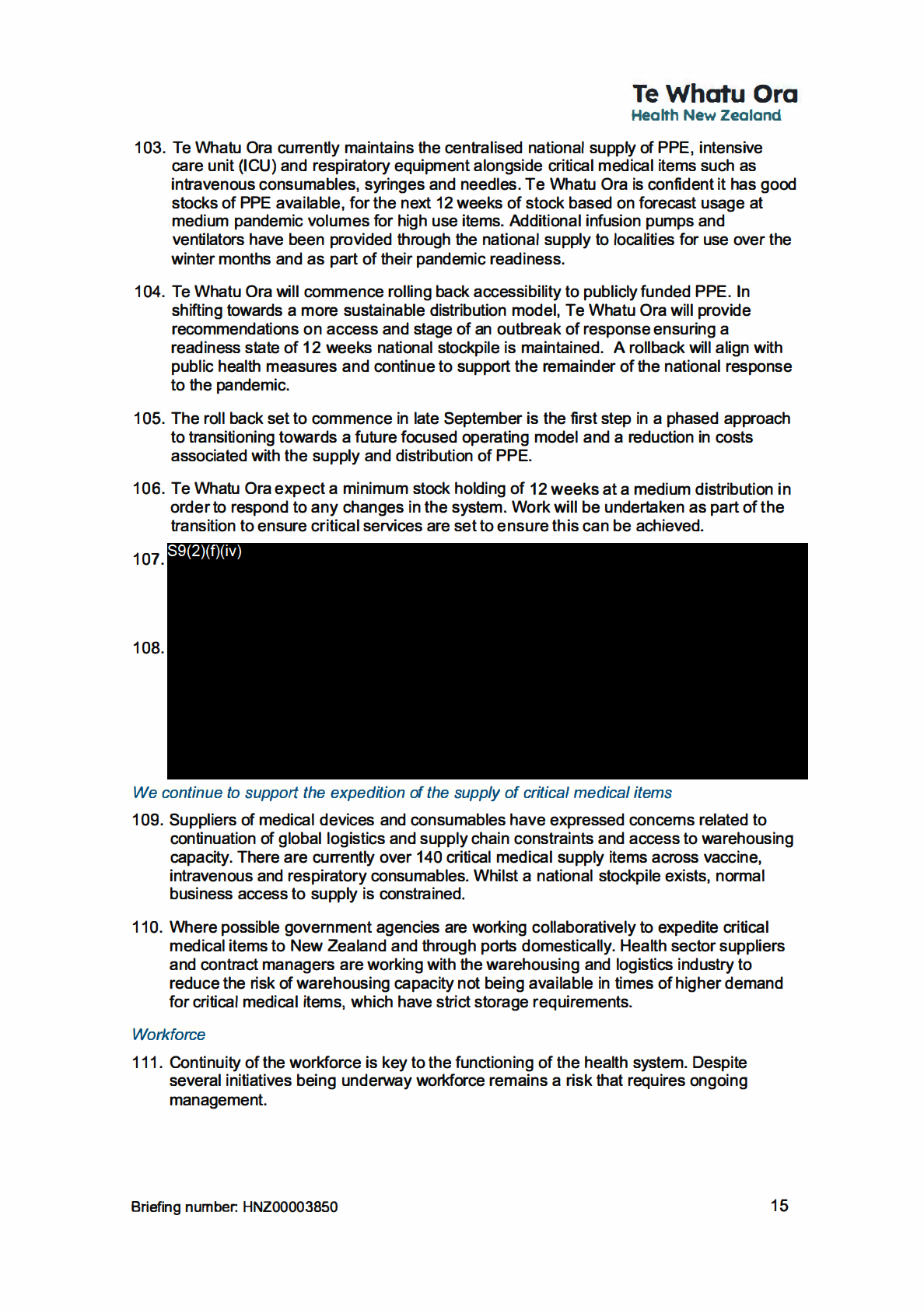
1982
ACT
INFORMATION
OFFICIAL
THE
UNDER
RELEASED
 TeWhatu Ora
TeWhatu Ora
Health New Zealand
112. On 1 August 2022, the Minister of Health announced a suite of targeted measures to
train more health workers domestically and bring more doctors and nurses into the
county to help address immediate workforce pressures. These initiatives include:
• streamlining and funding the system for international health workers, included
doctors and nurses, to get their professional qualifications recognised in New
Zealand.
• expanding the Return to Nursing Support programme.
1982
113. We are working across the various workforce pipeline programmes to map the areas
where we may be able to traction to support a fast-track approach to meeting
registration requirements. We aim to identify areas to work with relevant RegulatoryACT
Authorities to explore these opportunities. The work is aligned with Manat0 Hauora and
the team working on the Regulatory Authority reform.
114. The Aged Residential Care (ARC) workforce is currently considered to be at higher
risk. Measures to help address this risk are improving rates of influenza vaccination,
and assessing staff deployment and contingency plans as part of the Ministry of
Health's overall winter preparedness work. The available resources and planning
activity to date means that the ARC sector is relatively well prepared to manage the five
variant scenarios, contingent on workforce being available to do so.
115. Our community led workforce through Care in Community Hubs capacity is critical to
the success of COVID-19 wholistic health and social supports. Baseline capacity and
INFORMATION
capability and increasing this valuable skills pipeline for the health care workforce of the
future will be a focus over the coming months. The current community led workforce
within the Care in Community hubs target supports to our priority populations in areas
such as vaccine, community led supports to testing, and kanohi ki te kanohi access
alongside National Investigation and tracing Centre support to navigate information and
communicate advice on testing, isolation and care access.
Case management, clinical operations
OFFICIAL
and therapeutics
116. Ensuring safe and effective care for people with COVI D-19 and its long-term effects
requires strategic operational alignment of available evidence into guidance, and a
THE
strategic approach to assessment and management across the continuum of primary,
emergency, critical, and rehabilitative care. Effective management of COVID-19
requires mechanisms for early recognition, triage and safe patient flow, and access to
reliable diagnostics and timely resuscitation and treatment. Our health care systems
must be ready to respond to the varying needs of people with mild, moderate, severe
and critical disease, and to identify those suffering delayed consequences of infection,
UNDER
including those who may not have been diagnosed at the time of acute infection. Or
those who don't have equitable access to appropriate and effective health services.
Care in the community is undertaking work to guide its programme through to June 2023
117. Care in the Community has been fundamental to reducing the impacts of COVID-19 on
those who are more vulnerable. Care in the Community has established, and continues
to establish, a novel model of locally led care including:
• establishing
RELEASED
and enabling more than 50 care coordination hubs to provide clinical
and manaaki services in partnership with primary care and local organisations,
• standing up the National Alternative Accommodation Service (NAAS) with MSD,
MBIE and other agencies,
Briefing number: HNZ00003850
16
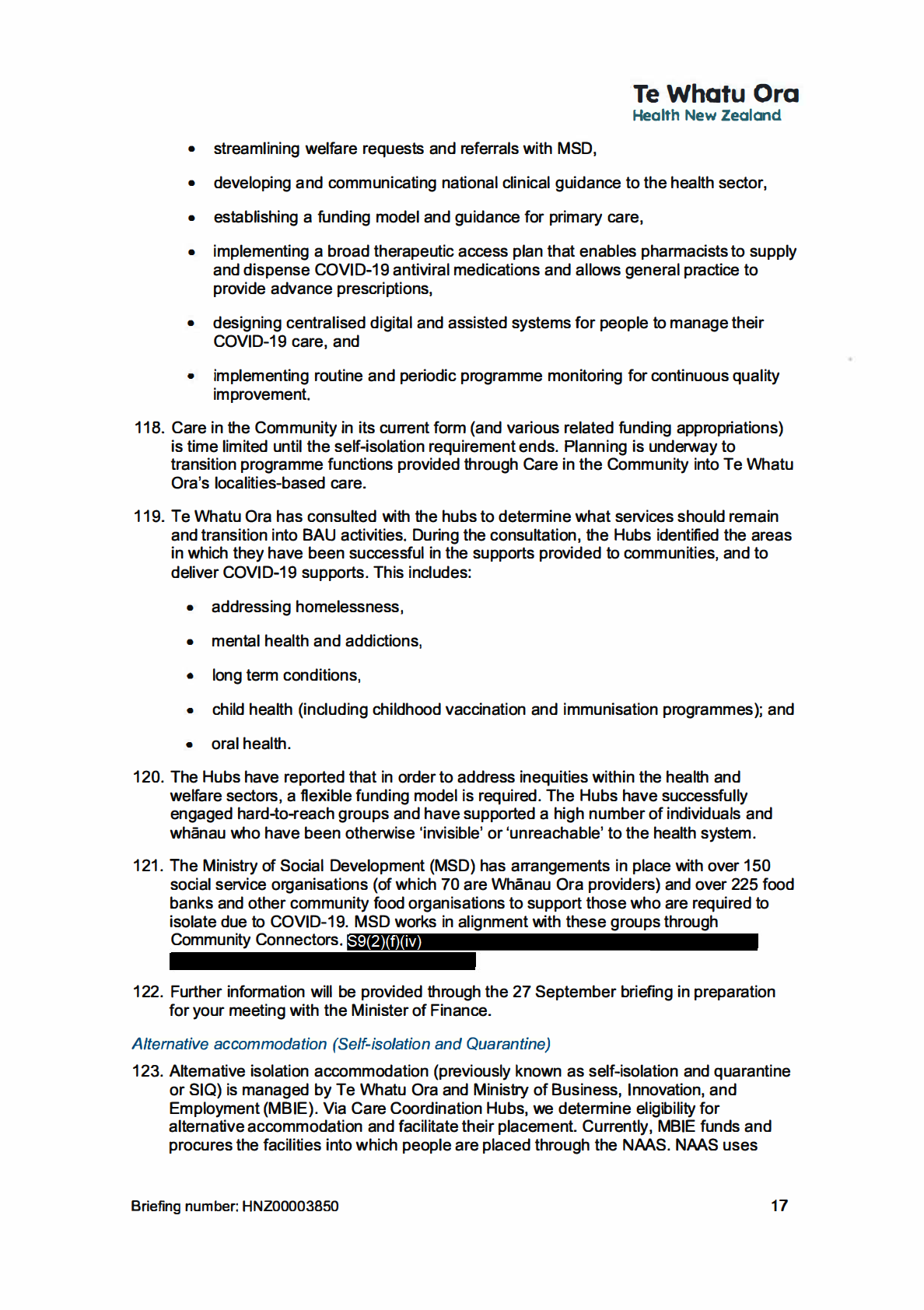
1982
ACT
INFORMATION
OFFICIAL
THE
UNDER
RELEASED
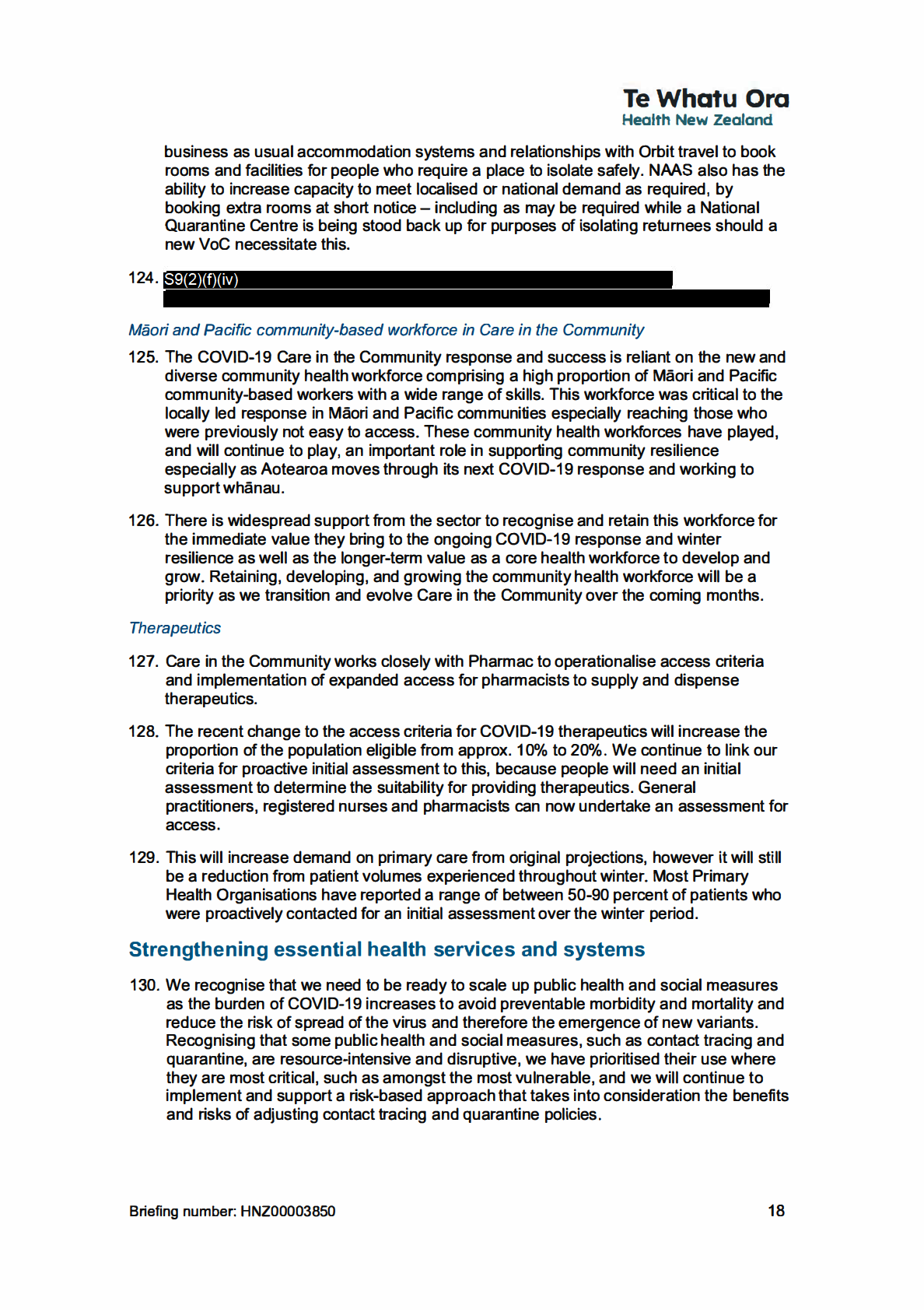
1982
ACT
INFORMATION
OFFICIAL
THE
UNDER
RELEASED
 TeWhatu Ora
Health New Zealand
Hospital and intensive care capacity
TeWhatu Ora
Health New Zealand
Hospital and intensive care capacity
131. The government has invested in increasing the physical capacity of hospitals to
manage COVID-19 through a $1 00m investment in infrastructure. There has also been
an investment of $544.2m (over four years) to increase the capacity and capability of
critical care across the country. This investment will increase critical care beds by
around thirty percent.
132. Te Whatu Ora monitors hospital activity on a daily, weekly and monthly basis, to
understand the pressures and provide support as practicable. Regions are also taking
1982
a lead in developing regional solutions and initiatives to manage demand. Other
monitoring includes availability of ventilators, PPE, pharmaceuticals and therapeutics
central to the management of COVID-19 patients.
ACT
133. Hospitals continue to manage surge through redeployment of staff, deferring of planned
care and increasing capacity where possible. A number of staff have also been
upskilled to support trained critical care staff, in the event that capacity comes under
pressure.
134. The hospital sector has managed the multiple demands of COVID-19 and other
seasonal illnesses, together with optimising planned care delivery over the last two and
a half years and this will continue to be the case. However, the sector needs to be
supported with strong public health messaging aimed at minimising illness that may
require hospitalisation, so that the system does not become overwhelmed.
135. Te Whatu Ora has introduced a seasonal pressures operating model to help the
INFORMATION
system mitigate COVID-19 and seasonal pressures (both in terms of demand and
supply constraints such as staff sickness). The core components of this model include:
• nationally consistent approach to escalation and action, coordinated at a regional
level, to support delivery at district level
• standardised escalation triggers and processes
OFFICIAL
• priority actions for rapid delivery including:
o enhanced community response - expanding telehealth support,
expanding primary
THE care and community radiology capacity, virtual support
to ambulance services from hospital clinicians
o supporting hospital flow - primary care support via telehealth as an option
in EDs, more allied health and other capacity to support EDs and facilitate
increased weekend discharge
UNDER
o support for Aged Residential Care - medical and nursing support via
telehealth, staffing bureau approach to increase availability of nursing
staff.
136. Rural hospitals have and continue to have plans to manage outbreaks in their
communities. In general patients have only needed to be transferred to another facility
when they needed a higher level of care. Maintaining a high level of support for people
with COVID-19 in the community is key to managing the demand on smaller, isolated
facilities.
RELEASED
National telehealth services
137. The National Telehealth Services (NTS) provide centrally coordinated national and
local support for a wide range of programmes across the health sector and contribute
Briefing number: HNZ00003850
19
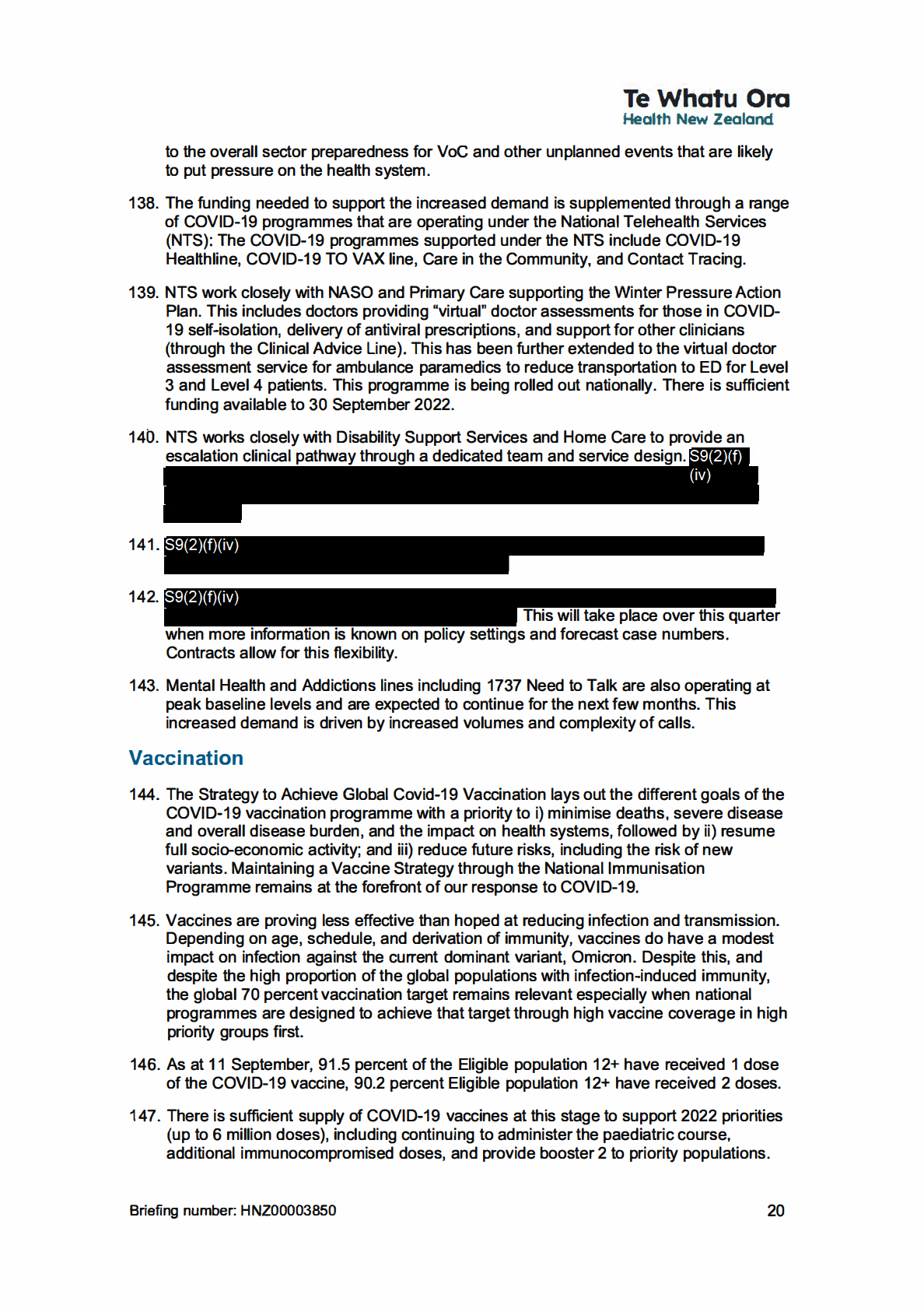
1982
ACT
INFORMATION
OFFICIAL
THE
UNDER
RELEASED
 TeWhatu Ora
TeWhatu Ora
Heclth New Zealand
We are currently developing our vaccine operating strategy beyond December 2022
148. The National Immunisation Programme (NIP) is currently developing its operating
strategy beyond December 2022. Cabinet SWC paper SWC-22-MIN-005 on April 6
2022 noted that officials will report back in the second half of 2022 on how the vaccine
programme is operating and the on-going COVID-19 NIP strategy. It was agreed that
the current model being worked towards will maintain NIP capability to scale in the
event of increased COVID-19 demands. Importantly the NIP COVID-19 strategic
priority will be to focus on protecting those most at risk of the impacts of COVID-19 by
enabling timely access to immunisations, with a particular focus on enabling Maori
1982
approaches. Overall, the operational model will give priority to Maori, Pacific peoples,
people living with disabilities, seniors, tamariki, and other groups that experience
inequities in COVID-19 outcomes.
ACT
149. The COVID-19 Immunisation Register (CIR) inventory functionality will be maintained
into 2023, other relevant storage and delivery contracts are set to expire in December
2022, extension of these contracts is subject to the National Immunisation
Programme's (NIP) future immunisation strategy report back due in the second half of
2022.
150. Existing Advance Purchase Agreements (APAs) can be leveraged to provide a route
for additional volumes of vaccine for 2023 or early access to updated variant vaccines
or expansion of vaccine eligibility to younger age groups. Currently scheduled
deliveries are remaining Pfizer deliveries in 2022 and Novavax deliveries in 2022 and
2023; these include delivery options for potential new variant vaccines and vaccines for
INFORMATION
wider population groups such as under 5s. There is planning being undertaken to
understand the value of additional purchasing agreements to maintain timely access to
effective and sufficient vaccine supplies. Such work will be led by Pharmac and
supported by NIP and the Public Health Authority (PHA), as all vaccine purchasing has
been transferred to Pharmac as of July 2022. Officials across PHA, Te Whatu Ora and
Te Aka Whai Ora will continue horizon scanning activities to maintain an understanding
of the evolving COVID-19 vaccine landscape and align APAs with potential Voes.
OFFICIAL
Settings are in place to manage any surge demand for vaccinators
151. While demand in the event of Voe outbreak may exceed that of the previous CVIP,
there is capacity to recall the authorised provisional workforce. In addition, there are
THE
2,198 provisional vaccinators without eOVID-19 vaccines within their current
authorisation who can be mobilised with training.
152. The Hands-Up pipeline for individuals interested in supporting the vaccinator workforce
is still running. This means it would be possible to expand the provisional vaccinators
unauthorised for COVID-19 vaccination as necessary. There is an additional 458
UNDER
COVID-19 vaccinators working under supervision (CVWUS), 46 of which have
completed the training to become a vaccinating health worker (VHW). The VHW is a
recently established role intended to replace CVWUS and expanding their scope of
vaccinations, including vaccinating 5-11s with the paediatric Pfizer vaccine. The VHW
workforce will be able to vaccinate until their authorisation renewal in July 2024.
Risk communication, community engagement and
infodemic management
RELEASED
153. To address the varied and dynamic eOVID-19 situations, alongside competing public
health priorities, we need to ensure our operational readiness for any eOVID-19
scenario is in the context of inevitable concurrent events. Localised responses need to
Briefing number: HNZ00003850
21
 TeWhatu Ora
Health New Zealand
TeWhatu Ora
Health New Zealand
be co-designed with communities to ensure relevance, acceptability, sustainability and
effectiveness.
154. The first goal of infodemic management for COVID-19 is to understand the nature of
the public conversation about the disease and the measures designed to protect
against it. Targeted and consistent information across various media channels with
good data and evidence continues to balance our response and social behaviours
toward measures.
Improve COVID-19 health outcomes for priority populations and vulnerable communities
1982
Maori
155. The COVID-19 outbreak has worsened the already inequitable health outcomes forACT
Maori. As measures are stepped down, Manato Hauora's Maori Protection Plan is
critical; this plan is currently due to expire in December 2022. Related response
measures are expected to continue to have a positive impact for Maori, including the
ongoing mandatory measures.
156. We have some well-established baseline measures in place, including high vaccination
rates. Across all ethnicities, 91.5 percent of people are at least partially vaccinated, and
73.2 percent of people eligible for first boosters have received them. For Maori, 86.7
percent of people are at least partially vaccinated and 56.3 percent of Maori eligible for
first boosters have received them. While we have high vaccination rates for at least one
dose, there is more work to be done in encouraging booster vaccination uptake among
Maori.
INFORMATION
Pacific peoples
157. Pacific peoples continue to be disproportionately affected by COVID-19 and continue to
experience long-standing inequitable health outcomes and service use. Recent data
shows proportionately Pacific peoples are most hospitalised for COVID-19 and their
COVID-19 mortality rate is four time greater than European or other ethnicities.
OFFICIAL
158. 91.6 percent of Pacific peoples are at least partially vaccinated (compared to 91.5
percent across all ethnicities) and 61.1 percent of eligible Pacific peoples have received
at least one booster dose (compared to 73.2 percent across all ethnicities). There is
more work to be done in encouraging booster vaccination uptake among Pacific
THE
peoples.
159. The response to the Pandemic has highlighted the strengths of our Pacific communities
and the capabilities of Pacific health providers to innovate and respond when supported
appropriately.
UNDER
160. Pacific health providers continue to face unprecedented demand and are delivering the
full spectrum of response activities alongside uplifting the vaccination service and
providing wraparound support, including for care in the community, to aiga and
whanau.
161. These providers formed a key part of the Government's response to outbreaks under
the COVID-19 Elimination Strategy and played a major role under the COVID-19
Protection Framework. The success of the ongoing response has been supported by
these providers' ability to maintain the vastly enhanced scope of response activities
RELEASED
compared to initially planned parameters.
Other groups
162. To ensure equitable and safe service coverage during COVID-19 events, a national
approach to services has been agreed for Home Care Support Service (HCSS) clients
Briefing number: HNZ00003850
22
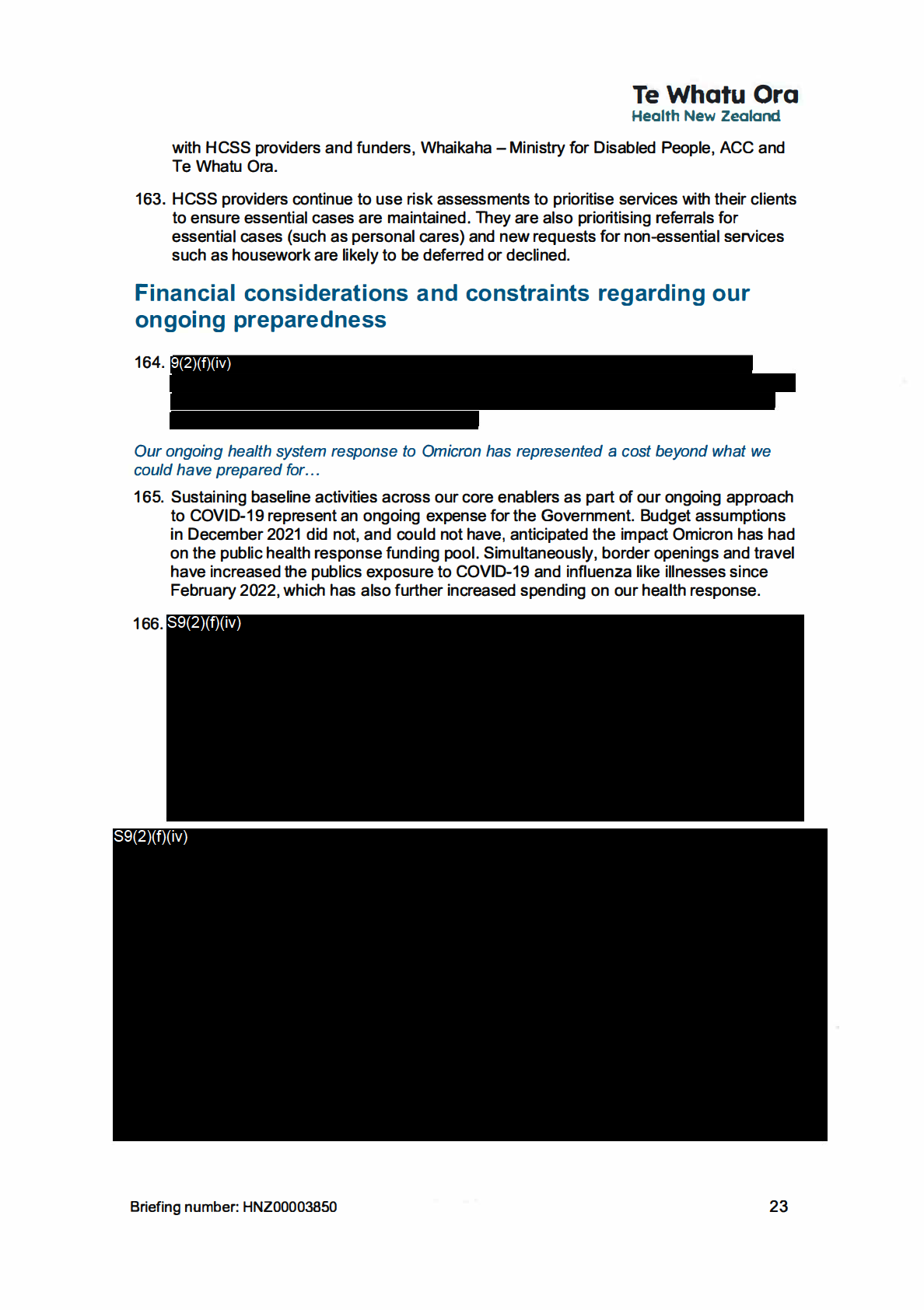
1982
ACT
INFORMATION
OFFICIAL
THE
UNDER
RELEASED
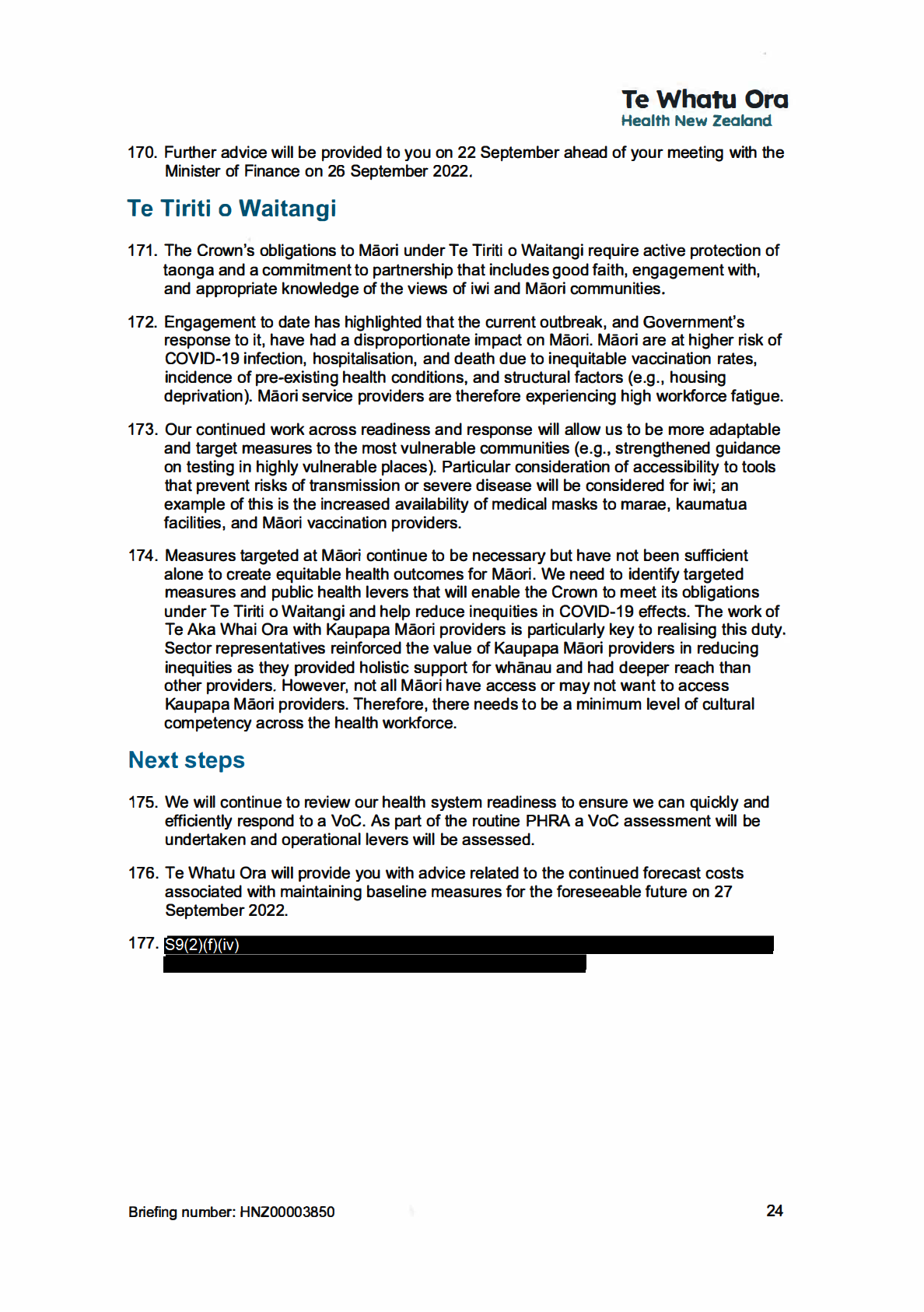
1982
ACT
INFORMATION
OFFICIAL
THE
UNDER
RELEASED


























